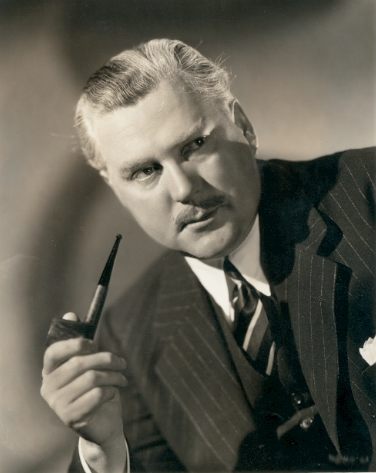
Nigel Bruce was a British character actor on stage and screen, best known as Doctor Watson in a series of films and in the radio series The New Adventures of Sherlock Holmes.
He was educated at The Grange, Stevenage, and at Abingdon School, Berkshire. Before World War I, he played first class cricket. He served in France from 1914 as a lieutenant in the 10th Service Battalion - Somerset Light Infantry, and the Honourable Artillery Company, but was severely wounded at Cambrai the following year, with eleven bullets in his left leg, and spent most of the remainder of the war in a wheelchair.
He made his first appearance on stage on May 12, 1920 at the Comedy Theatre as a footman in Why Marry? In October that year, he went to Canada as stage manager to Henry V. Esmond and Eva Moore, and also playing "Montague Jordan" in Eliza Comes to Stay; upon returning to England, he toured in the same part. He appeared constantly on stage thereafter, and eight years later, also started working in silent films. In 1934, he moved to Hollywood, later setting up home at 701 North Alpine Drive, Beverly Hills.
Nigel Bruce typically played buffoonish, fuzzy-minded gentlemen. During his film career, he worked in 78 movies, including Treasure Island (1934), The Scarlet Pimpernel (1934), The Trail of the Lonesome Pine (1936), Lassie Come Home (1943), and The Corn Is Green (1945). Bruce participated in two landmark films: Becky Sharp, the first feature film in full Technicolor, and Bwana Devil, the first 3-D feature. He also appeared in the Alfred Hitchcock films Rebecca (1940) and Suspicion (1941).
Bruce's signature role was that of Dr. Watson in the Sherlock Holmes series with his good friend Basil Rathbone. Bruce starred as Watson in 14 films (from 1939 to 1946) and over 200 radio programs. Although Watson often appears to be the older of the two main characters, Bruce was actually three years younger than his co-star Rathbone. Holmes purists objected that Watson in the books was an intelligent and capable person, and that the Bruce portrayal made him seem dimmer and more bumbling than his literary counterpart. Rathbone spoke highly of Bruce's portrayal, saying that Watson was one of the screen's most lovable characters. The Rathbone-Bruce film series lapsed with the death of producer-director Roy William Neill in 1946.
Bruce, known as "Willie" to his friends, was a leading member of the British movie colony in Los Angeles, and was captain of the Hollywood Cricket Club. Unlike some of his contemporaries, he never renounced his British citizenship despite his long residence in the United States, and he retained his membership of London's Garrick Club and Buck's Club until his death.
Bruce died from a heart attack in Santa Monica, California in 1953, aged 58. He was cremated, and his ashes stored in the vault at the Chapel of the Pines Crematory in Los Angeles.
His last movie, World for Ransom, was released posthumously in 1954.
He was educated at The Grange, Stevenage, and at Abingdon School, Berkshire. Before World War I, he played first class cricket. He served in France from 1914 as a lieutenant in the 10th Service Battalion - Somerset Light Infantry, and the Honourable Artillery Company, but was severely wounded at Cambrai the following year, with eleven bullets in his left leg, and spent most of the remainder of the war in a wheelchair.
He made his first appearance on stage on May 12, 1920 at the Comedy Theatre as a footman in Why Marry? In October that year, he went to Canada as stage manager to Henry V. Esmond and Eva Moore, and also playing "Montague Jordan" in Eliza Comes to Stay; upon returning to England, he toured in the same part. He appeared constantly on stage thereafter, and eight years later, also started working in silent films. In 1934, he moved to Hollywood, later setting up home at 701 North Alpine Drive, Beverly Hills.
Nigel Bruce typically played buffoonish, fuzzy-minded gentlemen. During his film career, he worked in 78 movies, including Treasure Island (1934), The Scarlet Pimpernel (1934), The Trail of the Lonesome Pine (1936), Lassie Come Home (1943), and The Corn Is Green (1945). Bruce participated in two landmark films: Becky Sharp, the first feature film in full Technicolor, and Bwana Devil, the first 3-D feature. He also appeared in the Alfred Hitchcock films Rebecca (1940) and Suspicion (1941).
Bruce's signature role was that of Dr. Watson in the Sherlock Holmes series with his good friend Basil Rathbone. Bruce starred as Watson in 14 films (from 1939 to 1946) and over 200 radio programs. Although Watson often appears to be the older of the two main characters, Bruce was actually three years younger than his co-star Rathbone. Holmes purists objected that Watson in the books was an intelligent and capable person, and that the Bruce portrayal made him seem dimmer and more bumbling than his literary counterpart. Rathbone spoke highly of Bruce's portrayal, saying that Watson was one of the screen's most lovable characters. The Rathbone-Bruce film series lapsed with the death of producer-director Roy William Neill in 1946.
Bruce, known as "Willie" to his friends, was a leading member of the British movie colony in Los Angeles, and was captain of the Hollywood Cricket Club. Unlike some of his contemporaries, he never renounced his British citizenship despite his long residence in the United States, and he retained his membership of London's Garrick Club and Buck's Club until his death.
Bruce died from a heart attack in Santa Monica, California in 1953, aged 58. He was cremated, and his ashes stored in the vault at the Chapel of the Pines Crematory in Los Angeles.
His last movie, World for Ransom, was released posthumously in 1954.